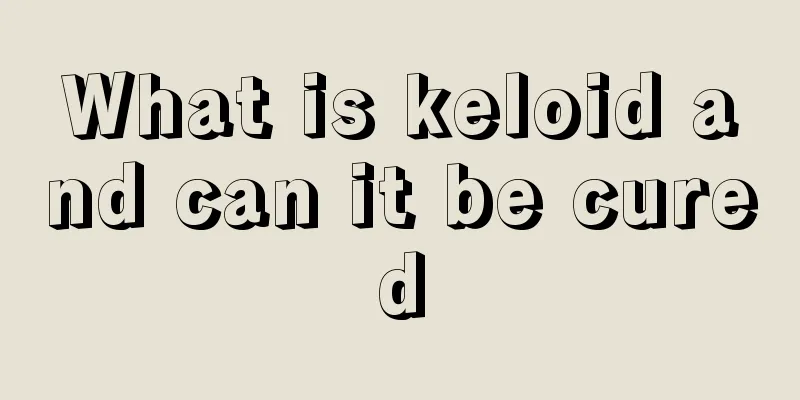What is keloid and can it be cured

|
Sometimes we see keloids on some people’s skin. They look very obvious, feel bumpy, are reddish, and are flaky or strip-shaped. Generally, this type of scar is caused by the body’s collagen synthesis and metabolism function losing its normal repair function after the skin injury heals, and exceeds the range of the body’s original skin damage. So, can this type of keloid be cured? Keloid is a stubborn disease that is difficult to cure. Currently, the treatments for this disease at home and abroad mostly use methods such as laser, freezing, surgical excision (skin grafting), radiotherapy or local hormone blockade. However, practice has shown that the therapeutic effects are not ideal. Not only are they prone to recurrence, but they can also stimulate scars to grow larger. This is especially true for acne-type keloids. If local hormone blockade is used, it will eventually lead to the growth of more acne and keloids, and the side effects of hormones are great. Histological studies have confirmed that hormone drugs cannot reduce the number of collagen fibers, that is, they cannot cure keloids fundamentally. Inappropriate stimulation will only cause retaliatory proliferation, so patients should be very cautious when using the above treatment methods. Surgical excision is the main means of treating mature scars or keloids. Commonly used surgical methods include scar excision and suture, skin grafting, flap transplantation, grinding, skin and soft tissue expansion, microsurgery, etc. Scar excision and suture, skin graft and skin flap transplant are the most commonly used. Surgery is effective in treating scars. In principle, scars should be removed as completely as possible. It is best to directly suture the scar through Z-reshaping or other plastic surgery after scar removal. For those who cannot directly suture and repair the wound, the use of skin flaps is better than skin grafting, and full-thickness skin grafting is better than blade-thickness skin grafting. However, given the extremely high recurrence rate of keloids after surgery, single surgical treatment is generally not recommended. Instead, early postoperative radiotherapy and drug injection treatment are recommended. Silicone is smooth, soft and non-irritating and was used as a cushion for pressure therapy in the early days. In 1983, Terkin et al. first reported the application of silicone membrane to treat scars. After a large number of clinical practices, it was proved that silicone membrane application has a certain effect in treating hypertrophic scars, which can reduce the local itching and pain of scars, promote scar softening, and even shrink scars. Its mechanism of action is still unclear, but it may be related to its pressure effect, hydration effect and biological activity of silica gel. Currently available products include silicone gel patches, spray preparations and ointments, which are mostly used for scar prevention and postoperative auxiliary treatment. With proper treatment, most keloids can become flat, soften, or even fade or disappear. The discomfort symptoms will be significantly reduced or disappear, and the aesthetics will be restored to a large extent. The most important thing is to choose the correct treatment method and treat it early. Research using modern scientific technology has shown that Chinese medicine has an impact on scar fibroblasts, collagen metabolism, promotion of granulation tissue epithelialization, blood and nutrient supply within scar tissue, etc., and has a certain effect on scar treatment. For example, Yulintang Scar Relief has a very good therapeutic effect. Traditional Chinese medicine has no side effects and is easy to use, but its effects are slow to take effect. Precautions ①Try to reduce mechanical, chemical and thermal stimulation to the affected area as much as possible, and avoid repeated pulling, rubbing and scratching of the keloid lesions to avoid ulceration and infection, which will aggravate the condition; ②It is best to wear loose cotton underwear to avoid allergies and tight clothing that may stimulate the lesions; ③ Eat more fruits, vegetables and other foods rich in vitamins, limit spicy foods, and avoid tobacco and alcohol; ④ Pay attention to personal hygiene, actively treat acne, and reduce the occurrence of skin infections. |
<<: How to treat closed acne, simple method to get rid of closed acne
>>: What's going on with this small bump on my upper jaw?
Recommend
Why does my left ear hurt?
If you experience ear pain, you need to pay close...
What to do if nasal cancer metastasizes to bone cancer
Many patients with nasal cancer have received var...
Eating carrots can prevent prostate cancer. Prostate cancer-prone groups
Nowadays, prostate has become one of the most com...
What should I do if my black and white clothes get stained?
People usually wear black and white clothes. If w...
What should patients with colorectal cancer pay attention to when exercising
What should patients with colorectal cancer pay a...
What are some effective pain relief methods for gallstones?
After suffering from gallstones, you must receive...
My stomach hurts from time to time. What's going on?
In our daily life, stomachache is a common thing....
I always want to have diarrhea but can't, what's going on?
I believe that many people are familiar with the ...
Can cataracts be treated with laser after they occur?
Cataracts are a relatively common eye disease in ...
Can soaking red dates and dandelions in water help dispel cold?
Dandelion is a very common plant nowadays. It has...
Pathological causes and early diagnosis of bladder carcinoma in situ
Bladder cancer can be classified in detail due to...
The efficacy, effects and contraindications of Schisandra chinensis
Schisandra chinensis is actually a traditional Ch...
The 5 most nourishing meat foods in winter
1. Lamb: The most nutritious meat Mutton can help...
Where is the dull pain in the kidney area?
The kidney is an important organ of the human bod...
There's a throbbing pain in my head
There are countless nerves in the human brain, an...









